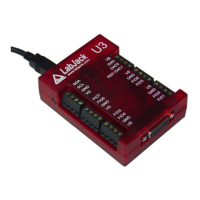5.2.5 Feedback
A flexible function that handles all command/response functionality. One or more IOTypes are
used to perform a single write/read or multiple writes/reads.
Note that the general protocol described in Section 4.1 defines byte 2 of an extended command
as the number of data words, which is the number of words in a packet beyond the first 3 (a
word is 2 bytes). Also note that the overall size of a packet must be an even number of bytes,
so in this case an extra 0x00 is added to the end of the command and/or response if needed to
accomplish this.
Since this command has a flexible size, byte 2 will vary. For instance, if a single IOType of
FIOStateRead (d14) is passed, byte 2 would be equal to 1 for the command and 2 for the
response. If a single IOType of LED (d9) is passed, an extra 0 must be added to the command
to make the packet have an even number of bytes, and byte 2 would be equal to 2. The
response would also need an extra 0 to be even, and byte 2 would be equal to 2.
, up to the
tgoing
. In the
• nse. A host application might pass
sequential numbers to ensure the responses are in order and associated with the proper
command.
Command:
Byte
0 Checksum8
10xF8
2 0.5 + Number of Data Words (IOTypes and Data)
30x00
4 Checksum16 (LSB)
5 Checksum16 (MSB)
6Echo
7-63 IOTypes and Data
Response:
Byte
0 Checksum8
10xF8
2 1.5 + Number of Data Words (If Errorcode = 0)
30x00
4 Checksum16 (LSB)
5 Checksum16 (MSB)
6 Errorcode
7 ErrorFrame
8Echo
9-63 Data
• IOTypes & Data: One or more IOTypes can be passed in a single command
maximum packet size. More info about the available IOTypes is below. In the ou
command each IOType is passed and accompanied by 0 or more data bytes
incoming response, only data bytes are returned without the IOTypes.
Echo: This byte is simply echoed back in the respo
87

